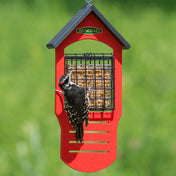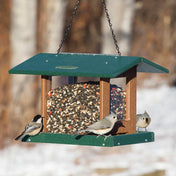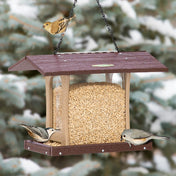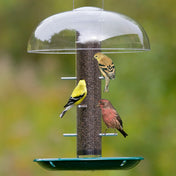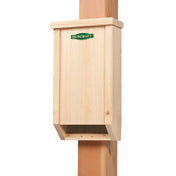Do bluebirds really bring happiness? If that’s true, here are some tips to bring more happiness to your backyard. If you already have bluebirds, implementing one or more of the following suggestions will provide some extra support. If you’re still hoping to attract them, these ideas will definitely help!
Bluebird Houses: Attract a Whole Family of Bluebirds!
Watching a breeding pair of bluebirds raise their fledglings might just be one of the most joyous experiences a backyard birder can have. If this sounds appealing to you, here are a few special steps you can take with your bluebird house to ensure that you are offering a safe and desirable home to your new tenants.
Placement: Bluebirds are most likely to occupy a house that is placed near a wide open habitat, such as in a field or pasture. However, this doesn’t mean that you can’t attract bluebirds to your backyard – just try to keep their preferences in mind. An effective strategy is to find a fairly open clearing in your yard, then strategically mount your bluebird house on a pole in that spot. You’ll want to use a pole that is about 6 feet tall for this purpose. Your bluebirds will love perching on top of their new home as they survey the lawn for tasty insects.
Predator Guards: Cats, snakes, raccoons, and even other birds will sometimes try to go after your bluebirds and their offspring. Fortunately, there are reliable ways to protect your birds from these would-be predators. One key strategy is to add a baffle to your pole. You may already be familiar with baffles as a device used to prevent squirrels from climbing up to a feeder. However, they are also wonderful tools for warding off snakes, rodents, and other critters that might want to climb up to your bird house. Bluebird houses can be further reinforced by making the entrance a little harder to infiltrate. A simple add-on like this Bird Guardian can make it difficult for predators like raccoons or cats to reach their arms into the box.
If you are looking for a top-notch bluebird house to get started with, check out our Bird-Safe® Bluebird House & Pole with Noel Guard. It comes with a 6-foot pole, and it has a nifty wire mesh Noel Guard that defends the entrance from large birds, raccoons, and other predators. It’s also constructed from a durable recycled plastic material that will maintain its attractive blue color for years to come.
Birdbaths: Keeping Your Bluebirds Clean and Hydrated
Water is as vital for birds as it is for us, for both drinking and bathing. Bluebirds seem to be more attracted to moving water, so consider adding a Water Wiggler, mister, fountain, or dripper to your bath. Keep the bath clean and filled, and watch the birds come to enjoy a splash and a drink. If the birds seem hesitant to approach your bath, try placing a few rocks in the bath and winding some native vines or branches around it to create a more natural feel. If you want to learn more about incorporating a birdbath into your backyard habitat, you might like to read our other article about creating a four-season water feature that your birds will love!
The Bluebird Buffet: Giving Your Bluebirds Some Options
Bluebirds are omnivores – you are just as likely to catch them snagging insects off your lawn as you are to see them plucking berries from your shrubs. For creative backyard birders like yourself, this means you can utilize a variety of strategies for enticing bluebirds to your yard.
Mealworms: Dried, roasted, or live and wiggling mealworms provide a great food source for bluebirds. Place feeders at least 20 feet away from the nest box, and not directly in front of the entrance hole. The nesting birds will appreciate the convenient food source, but prefer to have the hubbub of a busy feeder at a safe distance from the nest. Browse our huge selection of bluebird feeders to find the perfect one for your yard.
Hunting Perches: Bluebirds hunt by sitting on perches (think nest box lids, fence posts, and dead trees) about 3 to 6 feet high to look for their prey. Their eyesight is unbelievable — a bluebird can see an insect from 20 feet away and swoop down on it from the perch. After the bluebird has exhausted the territory he can see from one perch, he’ll move on to a perch in a new area. It’s easy to put up a few hunting perches for your bluebirds — it can be as simple as pounding a 4′ stake into the lawn every 20 feet or so. Keep the grass mowed in the area to make hunting even easier for your blue friends.
Fruit-bearing Plants: During the warm season, insects make up the bulk of the bluebirds’ diet. They supplement their summer diet with delicious fruits and berries. In the winter, when the insects are no longer available, bluebirds live on the fruit. Consider adding a few native, non-invasive shrubs, trees, and vines to your yard to provide the birds with nutritious fruit. A few favorites include Mountain Ash, Serviceberry, Elderberry, Eastern Red Cedar, Flowering Dogwood, and Virginia Creeper. These trees and shrubs will also provide safe cover and protection for your birds year-round. The experts at your local Cooperative Extension office can help you find the best varieties for your specific location.
Give us a call with any questions — we’re available Monday–Friday from 9:00am–5:00pm ET at (888) 879-5095. Happy Bluebirding!


